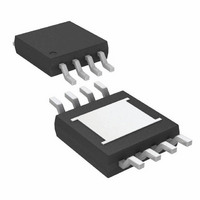LTC4440EMS8E#TR Linear Technology, LTC4440EMS8E#TR Datasheet - Page 7

LTC4440EMS8E#TR
Manufacturer Part Number
LTC4440EMS8E#TR
Description
IC DRIVER HIGH SIDE HS/HV 8MSOP
Manufacturer
Linear Technology
Type
High Sider
Datasheet
1.LTC4440ES6TRMPBF.pdf
(12 pages)
Specifications of LTC4440EMS8E#TR
Input Type
Non-Inverting
Number Of Outputs
1
On-state Resistance
1.5 Ohm
Current - Output / Channel
2.4A
Current - Peak Output
4A
Voltage - Supply
8 V ~ 15 V
Operating Temperature
-40°C ~ 85°C
Mounting Type
Surface Mount
Package / Case
8-MSOP Exposed Pad, 8-HMSOP, 8-eMSOP
Lead Free Status / RoHS Status
Contains lead / RoHS non-compliant
Available stocks
Company
Part Number
Manufacturer
Quantity
Price
APPLICATIO S I FOR ATIO
Overview
The LTC4440 receives a ground-referenced, low voltage
digital input signal to drive a high side N-channel power
MOSFET whose drain can float up to 100V above ground,
eliminating the need for a transformer between the low
voltage control signal and the high side gate driver. The
LTC4440 normally operates in applications with input
supply voltages (V
and continue to function during 100V, 100ms transients
on the input supply.
The powerful output driver of the LTC4440 reduces the
switching losses of the power MOSFET, which increase
with transition time. The LTC4440 is capable of driving a
1nF load with 10ns rise and 7ns fall times using a
bootstrapped supply voltage V
Input Stage
The LTC4440 employs TTL/CMOS compatible input thresh-
olds that allow a low voltage digital signal to drive standard
power MOSFETs. The LTC4440 contains an internal volt-
age regulator that biases the input buffer, allowing the input
thresholds (V
variations in V
V
ing transitions. However, care should be taken to keep this
pin from any noise pickup, especially in high frequency, high
voltage applications. The LTC4440 input buffer has a high
input impedance and draws negligible input current, sim-
plifying the drive circuitry required for the input.
Output Stage
A simplified version of the LTC4440’s output stage is
shown in Figure 3 . The pull-down device is an N-channel
MOSFET (N1) and the pull-up device is an NPN bipolar
junction transistor (Q1). The output swings from the lower
rail (TS) to within an NPN V
(BOOST). This large voltage swing is important in driving
external power MOSFETs, whose R
proportional to its gate overdrive voltage (V
The LTC4440’s peak pull-up (Q1) current is 2.4A while the
pull-down (N1) resistance is 1.5Ω. The low impedance of
N1 is required to discharge the power MOSFET’s gate
capacitance during high-to-low signal transitions. When
IL
eliminates false triggering due to noise during switch-
IH
CC
= 1.6V, V
. The 350mV hysteresis between V
IN
U
) up to 80V, but is able to withstand
IL
U
= 1.25V) to be independent of
BE
(~ 0.7V) of the positive rail
BOOST–TS
W
DS(ON)
of 12V.
GS
is inversely
U
– V
TH
IH
).
and
the power MOSFET’s gate is pulled low (gate shorted to
source through N1) by the LTC4440, its source (TS) is
pulled low by its load (e.g., an inductor or resistor). The
slew rate of the source/gate voltage causes current to flow
back to the MOSFET’s gate through the gate-to-drain
capacitance (C
sufficient sink current capability (low output impedance),
the current through the power MOSFET’s C
mentarily pull the gate high, turning the MOSFET back on.
A similar scenario exists when the LTC4440 is used to
drive a low side MOSFET. When the low side power
MOSFET’s gate is pulled low by the LTC4440, its drain
voltage is pulled high by its load (e.g., inductor or resis-
tor). The slew rate of the drain voltage causes current to
flow back to the MOSFET’s gate through its gate-to-drain
capacitance. If the MOSFET driver does not have sufficient
sink current capability (low output impedance), the cur-
rent through the power MOSFET’s C
pull the gate high, turning the MOSFET back on.
Rise/Fall Time
Since the power MOSFET generally accounts for the
majority of the power loss in a converter, it is important to
quickly turn it on or off, thereby minimizing the transition
time in its linear region. The LTC4440 can drive a 1nF load
with a 10ns rise time and 7ns fall time.
The LTC4440’s rise and fall times are determined by the
peak current capabilities of Q1 and N1. The predriver that
drives Q1 and N1 uses a nonoverlapping transition scheme
to minimize cross-conduction currents. N1 is fully turned
off before Q1 is turned on and vice versa.
Figure 3. Capacitance Seen by TG During Switching
LTC4440
GD
BOOST
). If the MOSFET driver does not have
TS
Q1
N1
TG
C
C
UP TO 100V
GD
GS
GD
V
IN
INDUCTOR
LTC4440
POWER
MOSFET
can momentarily
LOAD
4440 F03
GD
V
can mo-
–
7
4440f













